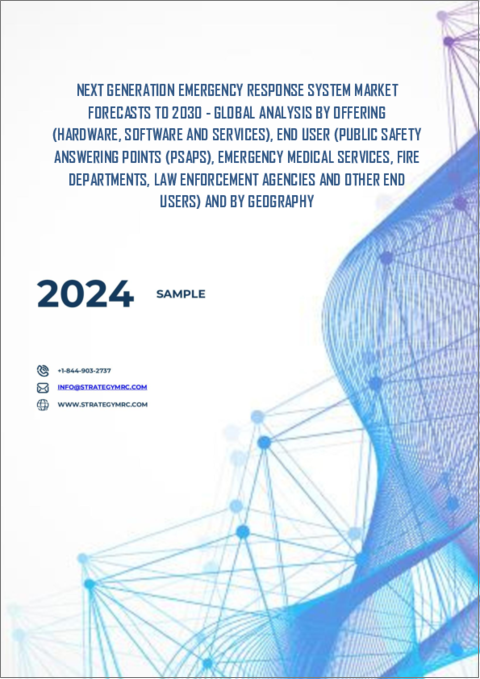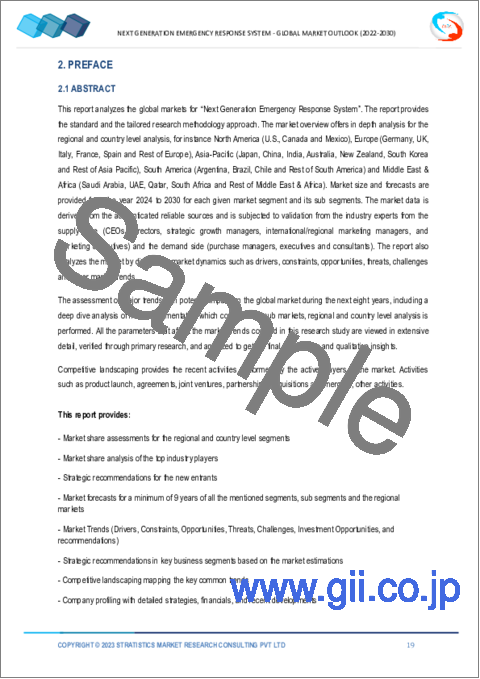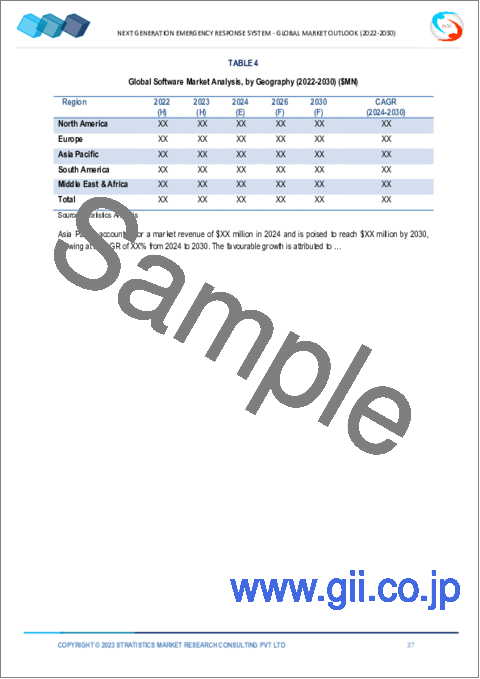|
|
市場調査レポート
商品コード
1489462
次世代緊急対応システム市場の2030年までの予測: オファリング別、エンドユーザー別、地域別の世界分析Next Generation Emergency Response System Market Forecasts to 2030 - Global Analysis By Offering, End User (Public Safety Answering Points, Emergency Medical Services, Fire Departments, Law Enforcement Agencies and Other End Users) and By Geography |
||||||
カスタマイズ可能
|
|||||||
| 次世代緊急対応システム市場の2030年までの予測: オファリング別、エンドユーザー別、地域別の世界分析 |
|
出版日: 2024年06月06日
発行: Stratistics Market Research Consulting
ページ情報: 英文 200+ Pages
納期: 2~3営業日
|
全表示
- 概要
- 図表
- 目次
Stratistics MRCによると、世界の次世代緊急対応システム市場は2023年に23億米ドルを占め、予測期間中のCAGRは7.4%で、2030年には38億米ドルに達する見込みです。
次世代緊急対応システムは、人工知能、リアルタイムデータ分析、IoTセンサー、地理空間マッピングなどの先進技術を統合し、緊急事態への備え、対応、復旧作業を強化します。これにより、インシデントの迅速な特定、効率的な資源配分、被災住民とのタイムリーなコミュニケーション、対応機関間の効果的な調整が可能になり、最終的には全体的な緊急対応の有効性と回復力が向上します。
全米緊急電話番号協会(NENA)の試算によると、全米でNG911が完全に導入されれば、緊急対応時間を短縮し、位置情報の精度を向上させることで、年間1万人以上の命を救うことができます。
災害頻度の増加
ハリケーン、洪水、山火事などの自然災害の発生頻度の増加は、次世代緊急対応システム市場の重要な促進要因です。こうした災害の発生が一般的になるにつれて、高度で効率的な緊急対応システムの必要性が高まっています。次世代システムは、通信、調整、状況認識能力を向上させ、緊急対応者が災害により迅速かつ効果的に対応できるようにします。より良い災害管理と対応に対する需要の高まりが、こうした先進的なシステムの採用を後押しし、市場の成長に寄与しています。
インフラの限界
既存の緊急対応システムの多くは、旧式の通信ネットワークや帯域幅の制限など、時代遅れのインフラに依存しています。次世代機能をサポートするためにこれらのシステムをアップグレードするには、高速ネットワーク、データセンター、高度な通信技術などのインフラに多額の投資を行う必要があります。インフラのアップグレードに伴う高コストや、地域によっては資金不足が、次世代緊急対応システムの普及を妨げ、市場の成長性を制限する可能性があります。
消費者教育と意識向上
位置精度の向上、リアルタイムのデータ共有、状況認識の強化など、こうした高度なシステムの機能について一般消費者の理解が深まれば、その導入を支持・擁護する可能性が高まる。よりよい救急サービスを求める市民の要望は、政府や民間セクターの次世代システムへの投資を促進することができます。消費者教育と啓蒙キャンペーンに注力することで、市場関係者はこの機会を活用し、こうした高度な緊急対応ソリューションの採用を加速させることができます。
自然災害と人災
地震やハリケーンなどの自然災害は、通信ネットワークや電力網など、緊急対応システムの運用に不可欠な重要インフラに損害を与える可能性があります。サイバー攻撃やテロ行為などの人為的な混乱も、緊急対応システムを標的とし、その機能を低下させ、人命を危険にさらす可能性があります。こうした混乱は、緊急対応システムの有効性に対する社会的信頼を損ない、市場の成長を妨げる可能性があります。
COVID-19の影響:
COVID-19の大流行は、効果的な緊急対応システムの重要性を浮き彫りにしました。パンデミックは既存の医療インフラと救急サービスに負担をかけ、大規模な危機に対応できる高度なシステムの必要性を強調しました。次世代緊急対応システムは、医療提供者、政府機関、一般市民間での迅速な情報共有、資源配分、調整を可能にし、パンデミックの管理において重要な役割を果たしました。
予測期間中、ハードウェア分野が最大となる見込み
次世代緊急対応システム市場では、予測期間中、ハードウェア分野が最大のシェアを占めると予想されます。5Gネットワーク、モノのインターネット(IoT)デバイス、エッジコンピューティングなどの高度なハードウェア技術の採用が増加していることが、このセグメントの成長を促進しています。緊急対応機関が次世代機能をサポートするためにハードウェア・インフラのアップグレードに投資していることから、ハードウェア・セグメントは市場において支配的な地位を維持する見通しです。
法執行機関セグメントは予測期間中に最も高いCAGRが見込まれる
次世代緊急対応システム市場において、法執行機関セグメントは予測期間中に最も高い成長率を記録すると予測されています。法執行機関は、緊急対応能力を向上させるために次世代技術の採用を増やしています。予測的取り締まりやリアルタイムの犯罪マッピングなど、スマートな取り締まりソリューションに対する需要の高まりが、このセグメントの急成長を後押ししています。法執行機関は、犯罪と闘い、公共の安全を確保するために、次世代緊急対応システムへの投資を続けているため、法執行機関セグメントは、市場で最も高い成長率を示すと予想されます。
最大のシェアを占める地域:
北米地域が次世代緊急対応システム市場で最大のシェアを占めると予想されます。同地域は緊急対応インフラが確立されており、この分野の技術革新を推進する大手テクノロジー企業が複数存在します。米国政府が国土安全保障に注力し、高度な緊急対応技術に投資していることも、この地域の優位性を高めています。さらに、北米ではハリケーンや山火事などの自然災害が頻発しているため、次世代緊急対応システムへの需要が高まっています。
CAGRが最も高い地域:
アジア太平洋地域は、予測期間中に次世代緊急対応システム市場で最も高いCAGRを示すと予想されます。この地域の急速な経済成長、都市化、人口密度の増加が、高度な緊急対応システムの需要を促進しています。中国、インド、日本などの国々は、次世代緊急対応技術の導入を含むスマートシティ構想に多額の投資を行っています。アジア太平洋地域の政府は公共の安全を優先し、インフラのアップグレードに投資しているため、次世代緊急対応システム市場は他の地域と比較して最も高い成長率が見込まれています。
無料のカスタマイズ提供:
本レポートをご購読のお客様には、以下のカスタマイズオプションのいずれかを無料でご提供いたします:
- 企業プロファイリング
- 追加市場プレーヤーの包括的プロファイリング(3社まで)
- 主要企業のSWOT分析(3社まで)
- 地域セグメンテーション
- お客様のご希望に沿った主要国の市場推定、予測、CAGR(注:フィージビリティチェックによる)
- 競合ベンチマーキング
- 製品ポートフォリオ、地理的プレゼンス、戦略的提携に基づく主要企業のベンチマーキング
目次
第1章 エグゼクティブサマリー
第2章 序文
- 概要
- ステークホルダー
- 調査範囲
- 調査手法
- データマイニング
- データ分析
- データ検証
- 調査アプローチ
- 調査情報源
- 1次調査情報源
- 2次調査情報源
- 前提条件
第3章 市場動向分析
- 促進要因
- 抑制要因
- 機会
- 脅威
- エンドユーザー分析
- 新興市場
- COVID-19の影響
第4章 ポーターのファイブフォース分析
- 供給企業の交渉力
- 買い手の交渉力
- 代替品の脅威
- 新規参入業者の脅威
- 競争企業間の敵対関係
第5章 世界の次世代緊急対応システム市場:オファリング別
- ハードウェア
- 携帯電話通信機器
- IPベースの通信機器
- 無線周波数機器
- 衛星通信機器
- スイッチングおよびルーティング機器
- その他のハードウェア
- ソフトウェア
- 通話管理ソフトウェア
- 位置情報サービスソフトウェア
- マルチメディアサポートソフトウェア
- テキストメッセージングソフトウェア
- その他のソフトウェア
- サービス
- コンサルティング
- 統合
- マネージドサービス
- プロフェッショナルサービス
- トレーニングおよびサポートサービス
第6章 世界の次世代緊急対応システム市場:エンドユーザー別
- 公衆安全応答ポイント(PSAP)
- 救急医療サービス
- 消防署
- 法執行機関
- その他のエンドユーザー
第7章 世界の次世代緊急対応システム市場:地域別
- 北米
- 米国
- カナダ
- メキシコ
- 欧州
- ドイツ
- 英国
- イタリア
- フランス
- スペイン
- その他欧州
- アジア太平洋地域
- 日本
- 中国
- インド
- オーストラリア
- ニュージーランド
- 韓国
- その他アジア太平洋地域
- 南米
- アルゼンチン
- ブラジル
- チリ
- その他南米
- 中東・アフリカ
- サウジアラビア
- アラブ首長国連邦
- カタール
- 南アフリカ
- その他中東とアフリカ
第8章 主な発展
- 契約、パートナーシップ、コラボレーション、合弁事業
- 買収と合併
- 新製品発売
- 事業拡大
- その他の主要戦略
第9章 企業プロファイリング
- Airbus SE
- Apple Inc.
- AT&T, Inc.
- Blackberry Limited
- Carbyne Ltd.
- Cisco Systems, Inc.
- ENERGOINVEST Ltd.
- Esri
- General Dynamics Corporation
- Google LLC
- Harris Corporation
- Hexagon AB
- Huawei Technologies Co., Ltd.
- IBM Corporation
- Intrado
- Microsoft Corporation
- Motorola Solutions, Inc.
- Nokia Corporation
- RapidSOS, Inc.
- Siemens AG
List of Tables
- Table 1 Global Next Generation Emergency Response System Market Outlook, By Region (2021-2030) ($MN)
- Table 2 Global Next Generation Emergency Response System Market Outlook, By Offering (2021-2030) ($MN)
- Table 3 Global Next Generation Emergency Response System Market Outlook, By Hardware (2021-2030) ($MN)
- Table 4 Global Next Generation Emergency Response System Market Outlook, By Cellular Communication Equipment (2021-2030) ($MN)
- Table 5 Global Next Generation Emergency Response System Market Outlook, By IP-Based Communication Equipment (2021-2030) ($MN)
- Table 6 Global Next Generation Emergency Response System Market Outlook, By Radio Frequency Equipment (2021-2030) ($MN)
- Table 7 Global Next Generation Emergency Response System Market Outlook, By Satellite Communication Equipment (2021-2030) ($MN)
- Table 8 Global Next Generation Emergency Response System Market Outlook, By Switching & Routing Equipment (2021-2030) ($MN)
- Table 9 Global Next Generation Emergency Response System Market Outlook, By Other Hardware (2021-2030) ($MN)
- Table 10 Global Next Generation Emergency Response System Market Outlook, By Software (2021-2030) ($MN)
- Table 11 Global Next Generation Emergency Response System Market Outlook, By Call Management Software (2021-2030) ($MN)
- Table 12 Global Next Generation Emergency Response System Market Outlook, By Location-Based Services Software (2021-2030) ($MN)
- Table 13 Global Next Generation Emergency Response System Market Outlook, By Multimedia Support Software (2021-2030) ($MN)
- Table 14 Global Next Generation Emergency Response System Market Outlook, By Text Messaging Software (2021-2030) ($MN)
- Table 15 Global Next Generation Emergency Response System Market Outlook, By Other Software (2021-2030) ($MN)
- Table 16 Global Next Generation Emergency Response System Market Outlook, By Services (2021-2030) ($MN)
- Table 17 Global Next Generation Emergency Response System Market Outlook, By Consulting (2021-2030) ($MN)
- Table 18 Global Next Generation Emergency Response System Market Outlook, By Integration (2021-2030) ($MN)
- Table 19 Global Next Generation Emergency Response System Market Outlook, By Managed Services (2021-2030) ($MN)
- Table 20 Global Next Generation Emergency Response System Market Outlook, By Professional Services (2021-2030) ($MN)
- Table 21 Global Next Generation Emergency Response System Market Outlook, By Training & Support Services (2021-2030) ($MN)
- Table 22 Global Next Generation Emergency Response System Market Outlook, By End User (2021-2030) ($MN)
- Table 23 Global Next Generation Emergency Response System Market Outlook, By Public Safety Answering Points (PSAPs) (2021-2030) ($MN)
- Table 24 Global Next Generation Emergency Response System Market Outlook, By Emergency Medical Services (2021-2030) ($MN)
- Table 25 Global Next Generation Emergency Response System Market Outlook, By Fire Departments (2021-2030) ($MN)
- Table 26 Global Next Generation Emergency Response System Market Outlook, By Law Enforcement Agencies (2021-2030) ($MN)
- Table 27 Global Next Generation Emergency Response System Market Outlook, By Other End Users (2021-2030) ($MN)
Note: Tables for North America, Europe, APAC, South America, and Middle East & Africa Regions are also represented in the same manner as above.
According to Stratistics MRC, the Global Next Generation Emergency Response System Market is accounted for $2.3 billion in 2023 and is expected to reach $3.8 billion by 2030 growing at a CAGR of 7.4% during the forecast period. The next generation emergency response system integrates advanced technologies such as artificial intelligence, real-time data analytics, IoT sensors, and geospatial mapping to enhance emergency preparedness, response, and recovery efforts. It enables rapid identification of incidents, efficient resource allocation, timely communication with affected populations, and effective coordination among response agencies, ultimately improving overall emergency response effectiveness and resilience.
According to National Emergency Number Association (NENA) estimates, the full implementation of NG911 across the United States could save over 10,000 lives annually by reducing emergency response times and improving the accuracy of location information.
Market Dynamics:
Driver:
Increasing frequency of disasters
The increasing frequency of natural disasters, such as hurricanes, floods, and wildfires, is a significant driver for the next generation emergency response system market. As the occurrence of these disasters becomes more common, the need for advanced and efficient emergency response systems becomes more pressing. Next-generation systems offer improved communication, coordination, and situational awareness capabilities, enabling emergency responders to react more quickly and effectively to disasters. The growing demand for better disaster management and response drives the adoption of these advanced systems, contributing to the growth of the market.
Restraint:
Infrastructure limitations
Many existing emergency response systems rely on outdated infrastructure, such as legacy communication networks and limited bandwidth. Upgrading these systems to support next-generation capabilities requires significant investment in infrastructure, including high-speed networks, data centers, and advanced communication technologies. The high costs associated with infrastructure upgrades and the lack of funding in some regions can hinder the widespread adoption of next-generation emergency response systems, limiting the market's growth potential.
Opportunity:
Consumer education and awareness
As the public becomes more informed about the capabilities of these advanced systems, such as improved location accuracy, real-time data sharing, and enhanced situational awareness, they are more likely to support and advocate for their implementation. Public demand for better emergency services can drive government and private sector investments in next-generation systems. By focusing on consumer education and awareness campaigns, market players can tap into this opportunity and accelerate the adoption of these advanced emergency response solutions.
Threat:
Natural and man-made disruptions
Natural disasters, such as earthquakes and hurricanes, can damage critical infrastructure, including communication networks and power grids, which are essential for the operation of emergency response systems. Man-made disruptions, such as cyber attacks and acts of terrorism, can also target emergency response systems, compromising their functionality and putting lives at risk. These disruptions can erode public trust in the effectiveness of emergency response systems and hinder the market's growth.
Covid-19 Impact:
The COVID-19 pandemic has highlighted the importance of effective emergency response systems. The pandemic has strained existing healthcare infrastructure and emergency services, emphasizing the need for advanced systems that can handle large-scale crises. Next generation emergency response systems have played a crucial role in managing the pandemic, enabling rapid information sharing, resource allocation, and coordination among healthcare providers, government agencies, and the public.
The hardware segment is expected to be the largest during the forecast period
The hardware segment is expected to hold the largest share in the Next Generation Emergency Response System market during the forecast period. The increasing adoption of advanced hardware technologies, such as 5G networks, Internet of Things (IoT) devices, and edge computing, is driving the growth of this segment. As emergency response organizations invest in upgrading their hardware infrastructure to support next-generation capabilities, the hardware segment is poised to maintain its dominant position in the market.
The law enforcement agencies segment is expected to have the highest CAGR during the forecast period
The law enforcement agencies segment is projected to experience the highest growth rate during the forecast period in the next generation emergency response system market. Law enforcement agencies are increasingly adopting next-generation technologies to improve their emergency response capabilities. The growing demand for smart policing solutions, such as predictive policing and real-time crime mapping, is driving the rapid growth of this segment. As law enforcement agencies continue to invest in next-generation emergency response systems to combat crime and ensure public safety, the law enforcement agencies segment is expected to exhibit the highest growth rate in the market.
Region with largest share:
The North American region is expected to hold the largest share of the next generation emergency response system market. The region has a well-established emergency response infrastructure and is home to several leading technology companies that are driving innovation in the field. The U.S. government's focus on homeland security and investment in advanced emergency response technologies further contributes to the region's dominance. Additionally, the high frequency of natural disasters in North America, such as hurricanes and wildfires, creates a strong demand for next generation emergency response systems in the region.
Region with highest CAGR:
The Asia Pacific region is expected to exhibit the highest CAGR in the next generation emergency response system market during the forecast period. The region's rapid economic growth, urbanization, and increasing population density are driving the demand for advanced emergency response systems. Countries like China, India, and Japan are investing heavily in smart city initiatives, which include the deployment of next-generation emergency response technologies. As governments in the Asia Pacific region prioritize public safety and invest in infrastructure upgrades, the market for next generation emergency response systems is expected to grow at the highest rate compared to other regions.
Key players in the market
Some of the key players in Next Generation Emergency Response System Market include Airbus SE, Apple Inc., AT&T, Inc., Blackberry Limited, Carbyne Ltd., Cisco Systems, Inc., ENERGOINVEST Ltd., Esri, General Dynamics Corporation, Google LLC, Harris Corporation, Hexagon AB, Huawei Technologies Co., Ltd., IBM Corporation, Intrado, Microsoft Corporation, Motorola Solutions, Inc., Nokia Corporation, RapidSOS, Inc. and Siemens AG.
Key Developments:
In August 2023, Motorola Solutions, Inc. expanded its Next Generation Core Services (NGCS) portfolio with the introduction of the Command Central Router, a cloud-based 9-1-1 call routing platform. This i3-compliant solution, endorsed by the National Emergency Number Association (NENA), seamlessly integrates with Motorola Solutions' emergency call management products. It ensures reliable and mission-critical 9-1-1 call routing performance for public safety answering points (PSAPs) through a cloud-based platform.
In June 2023, AT&T, Inc. entered a partnership with Carbyne Ltd., a leading provider of public safety communications. This collaboration aims to enhance emergency response capabilities in communities by offering faster and more effective solutions. Additionally, the partnership facilitates a secure and reliable connection between AT&T ESInet(TM) and Public Safety Answering Points (PSAPs) to Carbyne APEX and Universe, cloud-native emergency call management and mapping solutions.
In May 2023, Saw Carbyne Ltd. forming a partnership with Tyler Technologies, Inc., a software solutions provider, with the goal of enhancing emergency response capabilities. Through this collaboration, Carbyne's Emergency Communication as a Service (ECaaS) technology will be integrated into Tyler's Enterprise CAD solution. This integration aims to establish a standardized approach to video calls and provide dispatchers with real-time, actionable data, thereby improving operational efficiency, transparency, and ultimately contributing to life-saving efforts.
Offerings Covered:
- Hardware
- Software
- Services
End Users Covered:
- Public Safety Answering Points (PSAPs)
- Emergency Medical Services
- Fire Departments
- Law Enforcement Agencies
- Other End Users
Regions Covered:
- North America
- US
- Canada
- Mexico
- Europe
- Germany
- UK
- Italy
- France
- Spain
- Rest of Europe
- Asia Pacific
- Japan
- China
- India
- Australia
- New Zealand
- South Korea
- Rest of Asia Pacific
- South America
- Argentina
- Brazil
- Chile
- Rest of South America
- Middle East & Africa
- Saudi Arabia
- UAE
- Qatar
- South Africa
- Rest of Middle East & Africa
What our report offers:
- Market share assessments for the regional and country-level segments
- Strategic recommendations for the new entrants
- Covers Market data for the years 2021, 2022, 2023, 2026, and 2030
- Market Trends (Drivers, Constraints, Opportunities, Threats, Challenges, Investment Opportunities, and recommendations)
- Strategic recommendations in key business segments based on the market estimations
- Competitive landscaping mapping the key common trends
- Company profiling with detailed strategies, financials, and recent developments
- Supply chain trends mapping the latest technological advancements
Free Customization Offerings:
All the customers of this report will be entitled to receive one of the following free customization options:
- Company Profiling
- Comprehensive profiling of additional market players (up to 3)
- SWOT Analysis of key players (up to 3)
- Regional Segmentation
- Market estimations, Forecasts and CAGR of any prominent country as per the client's interest (Note: Depends on feasibility check)
- Competitive Benchmarking
- Benchmarking of key players based on product portfolio, geographical presence, and strategic alliances
Table of Contents
1 Executive Summary
2 Preface
- 2.1 Abstract
- 2.2 Stake Holders
- 2.3 Research Scope
- 2.4 Research Methodology
- 2.4.1 Data Mining
- 2.4.2 Data Analysis
- 2.4.3 Data Validation
- 2.4.4 Research Approach
- 2.5 Research Sources
- 2.5.1 Primary Research Sources
- 2.5.2 Secondary Research Sources
- 2.5.3 Assumptions
3 Market Trend Analysis
- 3.1 Introduction
- 3.2 Drivers
- 3.3 Restraints
- 3.4 Opportunities
- 3.5 Threats
- 3.6 End User Analysis
- 3.7 Emerging Markets
- 3.8 Impact of Covid-19
4 Porters Five Force Analysis
- 4.1 Bargaining power of suppliers
- 4.2 Bargaining power of buyers
- 4.3 Threat of substitutes
- 4.4 Threat of new entrants
- 4.5 Competitive rivalry
5 Global Next Generation Emergency Response System Market, By Offering
- 5.1 Introduction
- 5.2 Hardware
- 5.2.1 Cellular Communication Equipment
- 5.2.2 IP-Based Communication Equipment
- 5.2.3 Radio Frequency Equipment
- 5.2.4 Satellite Communication Equipment
- 5.2.5 Switching & Routing Equipment
- 5.2.6 Other Hardware
- 5.3 Software
- 5.3.1 Call Management Software
- 5.3.2 Location-Based Services Software
- 5.3.3 Multimedia Support Software
- 5.3.4 Text Messaging Software
- 5.3.5 Other Software
- 5.4 Services
- 5.4.1 Consulting
- 5.4.2 Integration
- 5.4.3 Managed Services
- 5.4.4 Professional Services
- 5.4.5 Training & Support Services
6 Global Next Generation Emergency Response System Market, By End User
- 6.1 Introduction
- 6.2 Public Safety Answering Points (PSAPs)
- 6.3 Emergency Medical Services
- 6.4 Fire Departments
- 6.5 Law Enforcement Agencies
- 6.6 Other End Users
7 Global Next Generation Emergency Response System Market, By Geography
- 7.1 Introduction
- 7.2 North America
- 7.2.1 US
- 7.2.2 Canada
- 7.2.3 Mexico
- 7.3 Europe
- 7.3.1 Germany
- 7.3.2 UK
- 7.3.3 Italy
- 7.3.4 France
- 7.3.5 Spain
- 7.3.6 Rest of Europe
- 7.4 Asia Pacific
- 7.4.1 Japan
- 7.4.2 China
- 7.4.3 India
- 7.4.4 Australia
- 7.4.5 New Zealand
- 7.4.6 South Korea
- 7.4.7 Rest of Asia Pacific
- 7.5 South America
- 7.5.1 Argentina
- 7.5.2 Brazil
- 7.5.3 Chile
- 7.5.4 Rest of South America
- 7.6 Middle East & Africa
- 7.6.1 Saudi Arabia
- 7.6.2 UAE
- 7.6.3 Qatar
- 7.6.4 South Africa
- 7.6.5 Rest of Middle East & Africa
8 Key Developments
- 8.1 Agreements, Partnerships, Collaborations and Joint Ventures
- 8.2 Acquisitions & Mergers
- 8.3 New Product Launch
- 8.4 Expansions
- 8.5 Other Key Strategies
9 Company Profiling
- 9.1 Airbus SE
- 9.2 Apple Inc.
- 9.3 AT&T, Inc.
- 9.4 Blackberry Limited
- 9.5 Carbyne Ltd.
- 9.6 Cisco Systems, Inc.
- 9.7 ENERGOINVEST Ltd.
- 9.8 Esri
- 9.9 General Dynamics Corporation
- 9.10 Google LLC
- 9.11 Harris Corporation
- 9.12 Hexagon AB
- 9.13 Huawei Technologies Co., Ltd.
- 9.14 IBM Corporation
- 9.15 Intrado
- 9.16 Microsoft Corporation
- 9.17 Motorola Solutions, Inc.
- 9.18 Nokia Corporation
- 9.19 RapidSOS, Inc.
- 9.20 Siemens AG





